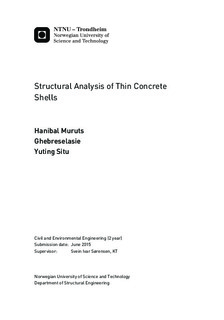Structural Analysis of Thin Concrete Shells
Master thesis
Permanent lenke
http://hdl.handle.net/11250/2351327Utgivelsesdato
2015Metadata
Vis full innførselSamlinger
Sammendrag
From the perspective of structural engineering, shells due to their spatial curvature, possessa structurally efficient way of carrying loads acting perpendicular to their surfaces.However, the nature and geometry of shells makes them complicated to understand orpredict their structural behaviour. The structural analysis of thin concrete shells canbe conducted numerically using finite element analysis(FEA) or/and analytically on thebasis of classical theory of thin shells. As finite element software are increasingly becomingprimary tools for performing structural analysis, the knowledge of the analyticalsolution methods are becoming somehow less known among young structural engineerstoday. Hence, this paper aims to revisit the analytical analysis methods for concrete shellstructures, and to investigate on how its results compare to that of the FEA. For a completeinvestigation of the structural analysis of thin concrete shells, the design and theaccompanying verification by using nonlinear FEA is also briefly included. The study islimited to structural static analysis.A combination of both a brief review of the theoretical background and a number of illustrativenumerical examples are used as the basis for this study. Both the theory andthe examples are focused on some of the most commonly build concrete shell structures,i.e axisymmetric shells and cylindrical shell roofs. Structural parts such as ring beamsand circular plates, which are normally associated with concrete shell structures are alsoincluded. The finite element analysis of the structures is the numerical examples are performedin a finite element software called DIANA. Following the linear FEA, some of thestructures in the numerical examples are designed accordingly, and analysed using nonlinearFEA. The nonlinear FEA are performed with the main focus on material utilizationand verification of the load carrying capacity. Both the design and load calculations aredone on the basis of the Eurocodes.In most of the numerical examples considered in this study, a relatively good agreementbetween the solutions obtained from the FEA and the analytical method is found. In thelast example, where a simply supported circular cylindrical shell roof is considered, thesolutions from the FEA has shown some deviation of varying magnitude compared to theanalytical solutions. Some of the possible sources of this deviation concerning assumptionsand mesh density are discussed. The nonlinear FEA of the selected RC structures showthat all the considered structures has the necessary capacity to carry the applied loading.Moreover the stress concentrations and crack patterns are relatively as one could expecton the basis of the linear FEA.Following this study it can be concluded that the analytical solution method providesa relatively safe and independent way of verifying the results obtained from the FEA.Moreover it provides a valuable insight into the structural behaviour of shells, which isvital for objectively evaluating the accuracy of results obtained from FEA of any shellstructure. The computations involved in the analytical solution procedure of concreteshell structures is however long and complicated thus it is highly exposed to calculationerrors. To avoid this errors it is advisable for structural engineers to make a script,spreadsheet or a simple software that is based on the analytical method.iii
